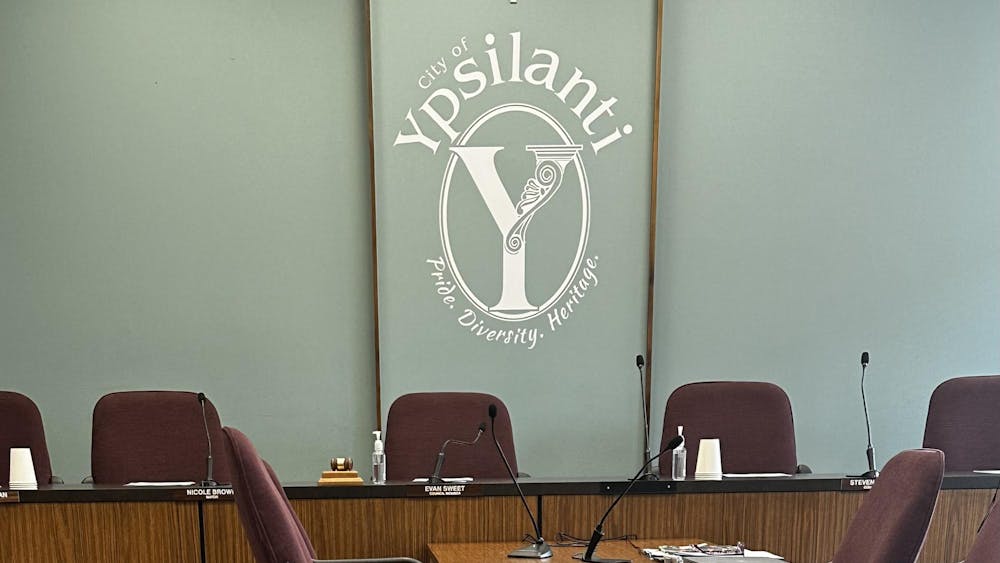Nuclear energy is a safe, cheap and clean alternative source of energy.
That’s what members of Clean Energy America, a nuclear energy advocacy group, came to Eastern Michigan University on Tuesday to say.
The CEA is comprised of professionals from the nuclear power industry. They primarily speak to students on college campuses. Mark Siedband, Ameren Missouri’s director of business planning, and Desirée Wolfgramm, a mechanical systems staff engineer for Energy Northwest, spoke to a group of around 20 students in a conference room on the third floor of the Student Center.
The two highlighted the positive aspects of nuclear power, including its minimal carbon footprint and the career opportunities it offers to college students.
According to Siedband, both concentrated solar power and solar photovoltaic systems are constructed from materials that result in carbon footprints two to four times as large as nuclear’s.
“A massive amount of natural resources are preserved thanks to nuclear power,” Siedband said. “It’s carbon and greenhouse gas free.”
Nuclear reactors are responsible for 20 percent of the United States power generation. The US is the world’s largest producer of nuclear energy. There are 100 reactors currently operating in the country, with several more under construction.
“It’s a growing industry,” Siedband said.
Michigan has four reactors currently operating. One of them, the Fermi II plant owned by Detroit Edison, is located less than an hour away from EMU’s campus.
DTE has even expressed interest in building a new reactor on the site and has already filed the 17,000-page application requesting permission to do so. If it receives approval and construction is on schedule, it could be operational by 2018.
“Nuclear is wonderful with jobs,” Wolfgramm said. “These are family wage jobs. They’re good jobs.”
The two biggest concerns regarding nuclear power are the perceived danger in harnessing it and the difficulties in disposing of its byproducts, such as spent fuel rods and other high level radioactive waste.
In the past 40 years, there have been three accidents involving nuclear power plants that qualify as “accidents with wider consequences” or higher, as classified by the International Nuclear Event Scale. These events are categorized by the release of radioactive material into the environment.
They occurred at the United States’ Three Mile Island power plant near Harrisburg, Pa. in 1979, the USSR’s Chernobyl power plant in 1986, and Japan’s Fukushima power plant in 2011.
Chernobyl and Fukushima were the two biggest disasters and earned the highest INES ratings. Only the Chernobyl accident resulted in any deaths, either directly or indirectly.
“We are a learning organization,” Wolfgramm said. “Regardless of where something happens, we look at it, we take the lessons learned and apply them to every individual plant.”
The safe disposal of high-level radioactive waste is the other concern often brought up opponents of nuclear power.
Spent nuclear fuel remains dangerously radioactive for thousands of years and because the U.S. does not have a centralized location for the safe disposal of nuclear waste, many power plants have resorted to storing them in large casks on site.
“My plant generates 64 square feet of radioactive material per year,” Wolfgramm said. “Nuclear power has generated enough used fuel in the past 60 years to fill a football field 7 yards deep.”
Wolfgramm added that by comparison, coal power plants generate enough hazardous material to fill a football field to the top of the stadium each year.
“Our used fuel is 100 percent contained,” Wolfgramm said. “The hazardous waste from coal plants is not 100 percent contained.”
The U.S. Congress has been attempting to create a centralized depository for nuclear waste in Nevada’s Yucca Mountain for the past 30 years, but legal and political opposition has prevented it from being used.









